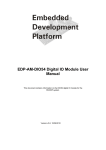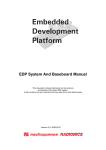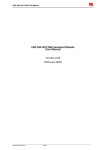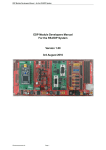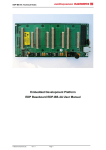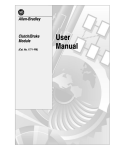Download EDP-AM-DIO54 Digital IO Module User Manual Version v4.0, 29/03
Transcript
EDP‐AM‐DIO54 Digital IO Module User Manual Version v4.0, 29/03/2010 This document contains information on the DIO54 digital IO module for the RS EDP system. EDP-AM-DIO54 Manual Contents 1. 1.1 1.2 1.3 1.4 1.4.1 1.4.2 1.4.3 1.4.4 1.4.5 1.5 1.5.1 1.5.2 1.5.3 1.5.4 1.5.5 1.6 1.7 Digital IO Module 3 Digital Outputs ............................................................................... 3 Using Multiple Digital IO Modules .................................................. 3 Software Drivers For Digital Module .............................................. 3 Digital IO Module Connectors ........................................................ 5 500mA Outputs.............................................................................. 5 I2C GPIO Outputs (25mA) ............................................................. 5 I2C GPIO Inputs (unprotected) ...................................................... 6 Protected Digital Inputs.................................................................. 6 Location Of Module Jumpers And Connectors............................... 7 Detailed Notes On Configuring The DIO54 Module For Use.......... 8 DIO54 Compatibility....................................................................... 8 Controlling The DIO54 Digital I/O Module...................................... 8 Digital Outputs ............................................................................... 8 Digital Inputs.................................................................................. 8 Mapping Of CPU Peripheral Pins To The Digital Module............... 9 Setting The Jumpers And Solder Bridges .................................... 10 Digital IO Module Jumper Settings .............................................. 12 © Electrocomponents plc Page 2 EDP-AM-DIO54 Manual 1. Digital IO Module The digital module provides a means to apply digital signals to the CM and drive world devices from it. There are 12 input channels with overvoltage protection and optional pull-ups, plus another 16 TTL inputs accessible only via I2C. 16 outputs are present each with a current drive capability of 500mA, plus another 16, 25mA logic outputs. The first 12 inputs and 16 outputs are derived from the CM (where possible), although the protected input stages and high-current output stages can be connected to the I2C IO expander also. The input I2C ports can generate an interrupt request. This is disabled by default as it could result in a high CPU interrupt loading. An RGB colour LED may be fitted for experimental purposes 1.1 Digital Outputs The 500mA outputs are simple low-side drives and are in the OFF state at power-up. They are designed to drive relays and solenoids and in fact can sink up to 1A but the user may need to attach a mini-heatsink to the driver IC if high duty ratios are expected. It is up to the user to program the digital output pins of the CPU to a logic ‘1’ to turn the outputs on. There is a net inversion through the drivers so that a logic ‘1’ at the CPU output pin will result in a low (i.e. current sink enabled) at the output connector. The user is provided with a software suite of drivers to allow the pins of the IO module to be controlled both by I2C and also via direct port manipulation of the MCU’s IO pins. All of the CMs provided by Hitex provide software support for the Digital IO Module Depending on the CPU module being used, not all of the 12 inputs and 16 outputs can be controlled independently. This is due to a potential shortage of IO pins on the CPU itself. In such cases, the duplicated or unavailable channels should be routed to one of the two I2C GPIO devices to make up the shortfall. 1.2 Using Multiple Digital IO Modules Up to 3 Digital IO Modules may be fitted to a single baseboard (4 if no CPU is fitted). Typically, the first module would make use of the CPU module’s own port pins. Other modules would rely on the I2C GPIO devices for their connection to the CPU. The full 8 I2C slave address variations is available to all these devices (via solder links on the AM). The user must make sure that there are no conflicts on IO pins on the backplane when more than one module is fitted. Alternatively, all digital IO modules could use I2C, freeing up CPU pins for other purposes. Where a second EDP baseboard is available, the I2C_GEN_0 I2C bus can be used to connect further digital IO modules. 1.3 Software Drivers For Digital Module The module has two I2C GPIO devices, both of which require special software drivers to access. These are provided for each of the CPU Modules. The software allows for control from both I2C bus commands and also via direct port control from the CPU. © Electrocomponents plc Page 3 EDP-AM-DIO54 Manual © Electrocomponents plc Page 4 EDP-AM-DIO54 Manual 1.4 Digital IO Module Connectors 1.4.1 500mA Outputs X202 Description X202 Description 1 DO0 1A output 2 DO8 1A output 3 DO1 1A output 4 DO9 1A output 5 DO2 1A output 6 DO10 1A output 7 DO3 1A output 8 DO11 1A output 9 DO4 1A output 10 DO12 500mA output 11 13 15 DO5 1A output DO6 1A output DO7 1A output 12 14 16 DO13 500mA output DO14 500mA output DO15 500mA output 17 DO16_L logic output 18 DO17_L logic output 19 DO18_L logic output 20 DO15 500mA output 21 CPU Vcc 22 12V GND 23 CPU Vcc 24 +12V Note: Although the outputs DO0 – DO11 are rated at 1 Amp you should take care that the maximum total ULN2003 power dissipation is not exceeded. 1.4.2 I2C GPIO Outputs (25mA) X203 Description X203 Description 1 GPIO OUT_P00 2 GPIO OUT_P10 3 GPIO OUT_P01 4 GPIO OUT_P11 5 GPIO OUT_P02 6 GPIO OUT_P12 7 GPIO OUT_P03 8 GPIO OUT_P13 9 GPIO OUT_P04 10 GPIO OUT_P14 11 GPIO OUT_P05 12 GPIO OUT_P15 13 GPIO OUT_P06 14 GPIO OUT_P16 15 GPIO OUT_P07 16 GPIO OUT_17 17 CPU Vcc 18 +3V3 19 +5V 20 SGND © Electrocomponents plc Page 5 EDP-AM-DIO54 Manual 1.4.3 I2C GPIO Inputs (unprotected) X204 Description X204 Description 1 GPIO IN_P00 2 GPIO IN_P10 3 GPIO IN_P01 4 GPIO IN_P11 5 GPIO IN_P02 6 GPIO IN_P12 7 GPIO IN_P03 8 GPIO IN_P13 9 GPIO IN_P04 10 GPIO IN_P14 11 GPIO IN_P05 12 GPIO IN_P15 13 GPIO IN_P06 14 GPIO IN_P16 15 GPIO IN_P07 16 GPIO IN_P17 17 CPU Vcc 18 +3V3 19 +5V 20 SGND 1.4.4 Protected Digital Inputs X205 Description X205 Description 1 DI0 input 2 DI8 input 3 DI1 input 4 DI9 input 5 DI2 input 6 DI10 input 7 DI3 input 8 DI11 input 9 DI4 input 10 DI12 input 11 DI5 input 12 DI13 input 13 DI6 input 14 DI14 input 15 DI7 input 16 DI15 input 17 CPU Vcc 18 +3V3 19 +5V 20 SGND © Electrocomponents plc Page 6 EDP-AM-DIO54 Manual 1.4.5 Location Of Module Jumpers And Connectors Top View © Electrocomponents plc Bottom View Page 7 EDP-AM-DIO54 Manual 1.5 Detailed Notes On Configuring The DIO54 Module For Use 1.5.1 DIO54 Compatibility The DIO54 module has been designed as a universal module which can accept any processor modules designed for the EDP system. As such it is important to note that there are a few limitations which the user needs to be aware of. You must check that the DIO54 is correctly configured for your CPU before fitting it to the EDP baseboard! 1.5.2 Controlling The DIO54 Digital I/O Module This module can be controlled by the CPU in several ways. On board the module are two independent serial I/O latch devices. Each of these devices has an input mode and an output mode function. The PCB has been designed such that one device is dedicated to output mode and the other device is dedicated for input mode. The chip used is the NXP PCA9555 device. The PCA9555 device can be controlled via the I2C0 channel on the CPU via the back plane. This I2C0 channel is referred to as the CNTRL I2C channel on the Baseboard. Each of the two PCA9555 devices has its own unique I2C address to communicate on. 1.5.3 Digital Outputs The PCA9555A device can be used to output data, the raw logic level output signals for this are referred to as OUT_P0(x) and OUT_P1(x) where x = 0 to7. These signals are available to probe on connector X203, and there are 16 logic level outputs in total. These raw logic level outputs can be fed into a high current Darlington driver of the type ULN2003. This however is a board option and the user has to configure the board to do this via a series of solder bridges. These bridges are B501-B508 and B602-B609. Check the board to ensure they are configured how you want them. The Darlington drive output from the ULN2003 appears on another connector X202, as signal DO(y) where y = 0 to 15. Note the output drive of DO(0)-DO(11) is double that of DO(12)-DO(15), due to the way the hardware has been implemented. The CPU also has some direct I/O capability and this feature is bought out onto the Baseboard. The Digital I/O Module has access to these signals and the user can use these rather than the signals produced by the I2C PCA9555 digital latches. On the Digital I/O Module these signals are referred to as EDP_DO(y) where y = 0 to 15. The mapping between the CPU’s port pins and the Output on the D0(y) pins is given later. 1.5.4 Digital Inputs The Digital I/O Module can also read in external input signals via an input buffer. The real world signals are referred to as DI(y) where y = 0 to 15. Signals DI(0) to DI(11) have an input protection stage and hex Schmitt trigger inverting buffer input whilst signals DI(12) to DI(15) have a different input protection arrangement. There are no buffers or inversion of these signals. The input signals after the protection stage can be routed via jumper links to either the serial input latches or to the STR9 MCU I/O pins. Jumpers J400 and J401 provide routing for 12 inputs DI(0) to DI(11) whilst input DI(12) to DI(15) have no routing capability and are fed directly into one of the PCA9555 serial latch device. The signals which are passed into the latches are referred to as IN_P0(x) and IN_P1(x) where x = 0 to 7, whilst the signals which pass directly into the MCU pins are referred to as EDP_DI(z) where z=0 to 11. © Electrocomponents plc Page 8 EDP-AM-DIO54 Manual There is no problems at all when the devices are configured as serial latch input device, although it’s worth noting that the same logic level when presented to DI(0) to DI(11) will read differently when presented to DI(12) to DI(15). This is because the DI(0) to DI(11) inputs have the Schmitt inverter in series with them. When the link options are organised for direct input digital reading it’s worth noting that there may be a share conflict with other modules that may require these I/O pins as output pins. 1.5.5 Mapping Of CPU Peripheral Pins To The Digital Module The mapping of the various CPU modules to the backplane is different for each CPU Module. This means the digital IO Module appears slightly differently for each CM that is fitted. An example of the mapping is shown below for two CPU modules. The provided software allows for easy reading and writing of values to the Digital IO Module. The software is different for each Command Module. XC167 Pin Allocation Vcc to BB STR9 Pin Allocation Vcc 3V3 or 5V, supplied by CM EDP‐AM‐DIO54 Allocation Vcc 3V3 or 5V, supplied by CM P3.5 P3.2 9 P6.2/CC2IO 8 P6.1/CC1IO 56 P2.15/CC15IO 55 P2.14/CC14IO 54 P2.13/CC13IO 53 P2.12/CC12IO 52 P2.11/CC11IO 51 P2.10/CC10IO 13 P6.6/CC6IO 12 P6.5/CC5IO 11 P6.3/CC4IO 10 P6.3/CC3IO 50 P2.9/CC9IO 49 P2.8/CC8IO P3.7 Digital GND Vcc 5V from reg P5.7 P5.6 P6.0 P4.7 P4.6 P4.5 P4.4 P4.3 P4.2 P4.0 P6.4 P6.3 P6.2 P6.1 P4.1 P4.0 P7.4 Digital GND 5V from baseboard regulator 3V3 from baseboard regulator 12V Power GND 12V Power GND +12V 2A +12V 2A IRQ_GPIO18_I2C GEN0 INT IRQ_GPIO16_CNTRL I2C INT EDP_DO9 EDP_DO8 EDP_DO7 EDP_DO6 EDP_DO5 EDP_DO4 EDP_DO3 EDP_DO2 EDP_DO13 EDP_DO12 EDP_DO11 EDP_DO10 EDP_DO1 EDP_DO0 EDP_DI11 Digital GND 5V from baseboard regulator Vcc 3V3 from reg 12V Power GND 12V Power GND +12V 2A +12V 2A © Electrocomponents plc 3V3 from baseboard regulator 12V Power GND 12V Power GND +12V 2A +12V 2A Page 9 EDP-AM-DIO54 Manual XC167 Pin Allocation Vcc to BB STR9 Pin Allocation Vcc 3V3 or 5V, supplied by CM EDP‐AM‐DIO54 Allocation Vcc 3V3 or 5V, supplied by CM 24 P9.3/CC19IO 55 P2.14/CC14IO 56 P2.15/CC15IO 21 P9.0/CC16IO 22 P9.1/CC17IO 23 P9./2CC18IO 131 P1H.4/CC24IO 132 P1H.5/CC25IO 133 P1H.6/CC26IO 134 P1H.7/CC27IO 15 P7.4/CC28IO 16 P7.5/CC29IO 17 P7.6/CC30IO P7.7/CC31IO (CS8900A INT) 124 P1L.7/CC22IO 124 P1L.7/CC22IO 127 P1H.0/CC23IO Digital GND Vcc 5V from reg P4.0 P0.1 P6.5 P4.6 P4.4 P4.2 P6.7 P6.6 P7.7 P7.6 P7.3 P7.2 P7.1 (PHY disabled) NC EDP_DO18 EDP_DO17 EDP_DO16 EDP_DO15 EDP_DO14 EDP_DI9 EDP_DI8 EDP_DI7 EDP_DI6 EDP_DI5 EDP_DI4 EDP_DI3 P7.0 P0.6 (PHY disabled) P0.5 (PHY disabled) P0.4 (PHY disabled) Digital GND 5V from baseboard regulator 3V3 from baseboard regulator 12V Power GND 12V Power GND +12V 2A +12V 2A EDP_DI2 EDP_DI10 EDP_DI1 EDP_DI0 Digital GND 5V from baseboard regulator Vcc 3V3 from reg 12V Power GND 12V Power GND +12V 2A +12V 2A 3V3 from baseboard regulator 12V Power GND 12V Power GND +12V 2A +12V 2A XC167 Pin Allocation Vcc 5V from reg Vcc 3V3 or 5V, supplied by CPU Vcc 3V3 from reg STR9 Pin Allocation Vcc 5V from reg Vcc 3V3 or 5V, supplied by CPU Vcc 3V3 from reg EDP‐AM‐DIO54 Allocation Vcc 5V from reg Vcc 3V3 or 5V, supplied by CPU Vcc 3V3 from reg 26 SCL2 P2.0 EDPCON2.79 25 SDA2 24 SCL1 23 SDA1 Digital GND P2.1 P2.2 P2.3 Digital GND EDPCON2.77 EDPCON2.7 EDPCON2.5 Digital GND Note: The shaded signals are not available with certain CPU modules. These inputs and outputs are recommended to be connected to the appropriate I2C GPIO device rather than relying on the CPU’s own port pins. 1.6 Setting The Jumpers And Solder Bridges To make the Digital I/O Module compatible with direct MCU drive from the I/O pins the solder jumpers mentioned above, B501-B508 and B602-B609 need to be set accordingly. This means the user has the option to drive the output directly from the MCU’s or via the PCA9555 serial latch depending on the jumper options. © Electrocomponents plc Page 10 EDP-AM-DIO54 Manual In terms of compatibility with other modules it is worth noting that the STR9 has on board ADC. These ADC channels are on Port4, so there is a potentially conflicting situation when used with the Analogue Module. I.e. The analogue module will present analogue values to Port4 whilst Port4 is trying to drive the Digital Module outputs. It is therefore prudent to reserve the Port4 pins for analogue input whilst using the Port6 pins for digital output. This means having some idea of what MCU system resources you will require in your design and modifying both the source code and the hardware to suite. The low level hardware drivers may therefore need to be modified when mixing modules to avoid this potential conflict. The Digital I/O Module can also read in external input signals via an input buffer. The real world signals are referred to as DI(y) where y = 0 to 15. Signals DI(0) to DI(11) have an input protection stage and hex Schmitt trigger inverting buffer input whilst signals DI(12) to DI(15) have a different input protection arrangement. There are no buffers or inversion of these signals. The input signals after the protection stage can be routed via jumper links to either the serial input latches or to the STR9 MCU I/O pins. Jumpers J400 and J401 provide routing for 12 inputs DI(0) to DI(11) whilst input DI(12) to DI(15) have no routing capability and are fed directly into one of the PCA9555 serial latch device. The signals which are passed into the latches are referred to as IN_P0(x) and IN_P1(x) where x = 0 to 7, whilst the signals which pass directly into the MCU pins are referred to as EDP_DI(z) where z=0 to 11. There is no problems at all when the devices are configured as serial latch input device, although it’s worth noting that the same logic level when presented to DI(0) to DI(11) will read differently when presented to DI(12) to DI(15). This is because the DI(0) to DI(11) inputs have the Schmitt inverter in series with them. When the link options are organised for direct input digital reading it’s worth noting that there may be a share conflict with other modules that may require these I/O pins as output pins. © Electrocomponents plc Page 11 EDP-AM-DIO54 Manual 1.7 Digital IO Module Jumper Settings Before fitting the DIO54 module to your EDP baseboard, you must configure the jumpers and solder bridges to suit the CPU module you are intending to use. The possible settings are given in the following table. Jumper Type Purpose Default State Default B300 Cut & Solder Set operating voltage of I2C GPIO devices Use CPU's Vcc 1-2 B301 B302 B303 B304 B305 B306 B307 B308 B309 B310 B311 B312 B313 B314 B400 B401 B402 B403 B404 B405 B406 B407 B408 B409 B410 B411 B412 B413 B414 B415 Cut & Solder Cut & Solder Cut & Solder Cut & Solder Cut & Solder Cut & Solder Cut & Solder Cut & Solder Cut & Solder Solder Solder Solder Solder Solder Cut Cut Cut Cut Cut Cut Cut Cut Cut Cut Cut Cut Cut Cut Cut Cut Select which I2C channel interrupt to use with both I2C GPIO devices Set address bit A0 for U300 (input) I2C GPIO device Set address bit A1 for U300 (input) I2C GPIO device Set address bit A2 for U300 (input) I2C GPIO device Set address bit A0 for U301 (output) I2C GPIO device Set address bit A1 for U301 (output) I2C GPIO device Set address bit A2 for U301 (output) I2C GPIO device Select I2C_CTRL bus or I2C GEN0 bus Select I2C_CTRL bus or I2C GEN0 bus Bypass PCA9306 Bypass PCA9306 Connect blue LED in RGB array to DO0 Connect green LED in RGB array to DO0 Connect red LED in RGB array to DO0 Pull up DI0 digital input to DIO54 module Pull up DI1 digital input to DIO54 module Pull up DI2 digital input to DIO54 module Pull up DI3 digital input to DIO54 module Pull up DI4 digital input to DIO54 module Pull up DI5 digital input to DIO54 module Pull up DI6 digital input to DIO54 module Pull up DI7 digital input to DIO54 module Pull up DI8 digital input to DIO54 module Pull up DI9 digital input to DIO54 module Pull up DI10 digital input to DIO54 module Pull up DI11 digital input to DIO54 module Pull up DI12 digital input to DIO54 module Pull up DI13 digital input to DIO54 module Pull up DI14 digital input to DIO54 module Pull up DI15 digital input to DIO54 module I2C_CTRL INT A0=0 A1=1 A2=0 A0=1 A1=1 A2=0 I2C_CTRL I2C_CTRL Not Bypassed Not Bypassed Not connected Not connected Not connected Pulled-up Pulled-up Pulled-up Pulled-up Pulled-up Pulled-up Pulled-up Pulled-up Pulled-up Pulled-up Pulled-up Pulled-up Pulled-up Pulled-up Pulled-up Pulled-up 1-2 1-2 2-3 1-2 2-3 2-3 1-2 1-2 1-2 Open Open Open Open Open Closed Closed Closed Closed Closed Closed Closed Closed Closed Closed Closed Closed Closed Closed Closed Closed = CPU output option may not be available with all EDP CPU modules © Electrocomponents plc Page 12 EDP-AM-DIO54 Manual Jumper Type B501 Cut & Solder B502 B503 B504 B505 B506 B507 B508 B602 B603 B604 B605 B606 B607 B608 B609 J400A J400B J400C J400D J400E J400F J401A J401B J401C J401D J401E J401F Cut & Solder Cut & Solder Cut & Solder Cut & Solder Cut & Solder Cut & Solder Cut & Solder Cut & Solder Cut & Solder Cut & Solder Cut & Solder Cut & Solder Cut & Solder Cut & Solder Cut & Solder Jumper Jumper Jumper Jumper Jumper Jumper Jumper Jumper Jumper Jumper Jumper Jumper Purpose Default State Default Connect ULN2003 input to either CPU output pin or U301 I2C GPIO device CPU output 1-2 Connect ULN2003 input to either CPU output pin or U301 I2C GPIO device Connect ULN2003 input to either CPU output pin or U301 I2C GPIO device Connect ULN2003 input to either CPU output pin or U301 I2C GPIO device Connect ULN2003 input to either CPU output pin or U301 I2C GPIO device Connect ULN2003 input to either CPU output pin or U301 I2C GPIO device Connect ULN2003 input to either CPU output pin or U301 I2C GPIO device Connect ULN2003 input to either CPU output pin or U301 I2C GPIO device Connect ULN2003 input to either CPU output pin or U301 I2C GPIO device Connect ULN2003 input to either CPU output pin or U301 I2C GPIO device Connect ULN2003 input to either CPU output pin or U301 I2C GPIO device Connect ULN2003 input to either CPU output pin or U301 I2C GPIO device Connect ULN2003 input to either CPU output pin or U301 I2C GPIO device Connect ULN2003 input to either CPU output pin or U301 I2C GPIO device Connect ULN2003 input to either CPU output pin or U301 I2C GPIO device Connect ULN2003 input to either CPU output pin or U301 I2C GPIO device Route DI0 input to CPU digital input pin via EDP or to I2C GPIO U300 Route DI0 input to CPU digital input pin via EDP or to I2C GPIO U300 Route DI0 input to CPU digital input pin via EDP or to I2C GPIO U300 Route DI0 input to CPU digital input pin via EDP or to I2C GPIO U300 Route DI0 input to CPU digital input pin via EDP or to I2C GPIO U300 Route DI0 input to CPU digital input pin via EDP or to I2C GPIO U300 Route DI0 input to CPU digital input pin via EDP or to I2C GPIO U300 Route DI0 input to CPU digital input pin via EDP or to I2C GPIO U300 Route DI0 input to CPU digital input pin via EDP or to I2C GPIO U300 Route DI0 input to CPU digital input pin via EDP or to I2C GPIO U300 Route DI0 input to CPU digital input pin via EDP or to I2C GPIO U300 Route DI0 input to CPU digital input pin via EDP or to I2C GPIO U300 CPU output CPU output CPU output CPU output CPU output CPU output CPU output CPU output CPU output CPU output CPU output CPU output CPU output CPU output CPU output Use CPU input Use CPU input Use CPU input Use CPU input Use CPU input Use CPU input Not fitted Not fitted Not fitted Not fitted Not fitted Not fitted 1-2 1-2 1-2 1-2 1-2 1-2 1-2 1-2 1-2 1-2 1-2 1-2 1-2 1-2 1-2 1-2 1-2 1-2 1-2 1-2 1-2 Open Open Open Open Open Open = CPU output option may not be available with all EDP CPU modules © Electrocomponents plc Page 13 EDP-AM-DIO54 Manual DIO54 ‐ Digital I/O Module Inputs to RS‐EDP Backplane X205 Digital Input Connector EVM0_GPIO21 J400 1 EVM1_GPIO23 EVM2_GPIO41_CAPADC EVM3_GPIO43 EVM4_GPIO45 EVM5_GPIO47 EVM6_GPIO49 EVM7_GPIO51 EVM8_GPIO53 EVM9_GPIO55 EVM10_GPIO68_ASCO_CTS J400 4 IRQ_GPIO22_I2C_INT 1 IRQ_GPIO16_CNTRL_I2C_INT IRQ_GPIO18_I2C_GEN0_INT CNTRL I2C 1 3 B308 2 1 I2C GEN0 7 J400 10 J400 13 J400 16 J401 1 J401 4 J401 7 J401 10 J401 13 J401 16 6 9 12 15 18 3 6 2 5 8 11 14 17 2 5 8 9 12 15 18 11 14 17 I2C Data I2C CLK DI(0) DI(1) DI(2) DI(3) DI(4) DI(5) DI(6) DI(7) DI(8) DI(9) DI(10) DI(11) DI(12) DI(13) DI(14) DI(15) B301 2 3 2 3 J400 3 I2C B309 DI(0) – DI(11) can be read via I2C or via backplane by the MCU DI(12) – DI(15) can only be read via I2C. Mapping Aid summary of Digital Input jumpers and IO configuration You can see from this diagram that inputs DI(0) to DI(15) provide the digital input pins to the system. The processed inputs are then made available on the backplane via the link options marked above as a diamond. If the inputs are required to be read via the I2C bus then the link can be set differently. DI(12) to DI(15) can only be read via the back plane and no I2C read option is available to them. The I2C interface can be selected as either CNTRL_I2C, which is the main I2C bus within the RS-EDP system or via the I2C_GEN0 bus which is usually provided as the user own I2C independent I2C bus. Not all CMs have two I2C channels so the default is usually CNTRL_I2C. Software drivers are provided for all the CMs to talk to the Digital IO Modules over the I2C protocol. The I2C device can generate an interrupt if required. The user can select this interrupt source via the link options shown above. © Electrocomponents plc Page 14 EDP-AM-DIO54 Manual DIO54 ‐ Digital I/O Module Outputs to RS‐EDP Backplane X202 Digital Output Connector EVG0_GPIO40 EVG1_GPIO42 EVG2_GPIO44 EVG3_GPIO46 EVG4_GPIO48 EVG5_GPIO50 EVG6_GPIO52 EVG7_GPIO54 EVG8_GPIO56 EVG10_GPIO58 EVG12_GPIO60 EVG14_GPIO62 B501 1 B502 1 B503 1 B504 1 B505 1 B506 1 B507 1 B508 1 B602 1 B603 1 B604 1 B605 1 EVG16_GPIO64 EVG18_GPIO66 EVG11_GPIO59 EVG13_GPIO61 B606 1 B607 1 B608 1 B609 1 EVG15_GPIO63 EVG17_GPIO65 EVG19_GPIO67 CNTRL I2C 1 3 3 3 3 3 3 3 3 3 3 3 3 3 3 3 3 2 DO(0) DO(1) DO(2) DO(3) DO(4) DO(5) DO(6) DO(7) DO(8) DO(9) DO(10) DO(11) 2 2 2 2 2 2 2 2 2 2 2 2 DO(12) DO(13) DO(14) DO(15) 2 2 2 DO(16) DO(17) DO(18) B308 2 1 2 3 I2C GEN0 3 I2C Data I2C CLK X500 GND Terminal I2C B509 B309 X500 DO(0) – DO(15) are Darlington outputs, controlled by either I2C or direct MCU control DO(16) – DO(18) are MCU logic level outputs controlled only by direct MCU 12VGND Mapping Aid summary of Digital Output jumpers and IO configuration As you can see from the diagram above the Digital IO Module can be fed with output data either directly from the back plane signals EVG0 to EVG19 or via I2C packets from the I2C buses. The user can select which of these two he wishes to use via the link options shown in the diamonds above. The diagram shows the same I2C bus interface which can be selected to be the same as the input module. i.e. CNTRL_I2C or I2C_GEN0 Note also the large X500 ground terminal which can be used to terminate large high current switching loads. As the backplane connections are only rated for up to 2A, for higher current loads the user should connect the high side load to the IO pin and use the X500 ground terminal for the return current from the load. Software drivers are provided for each CM to talk directly to the Digital IO Outputs both by I2C and also by direct MCU port control. © Electrocomponents plc Page 15















